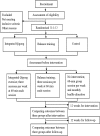Study protocol for a single-blind randomised controlled trial to evaluate the clinical effects of an Integrated Qigong exercise intervention on freezing of gait in Parkinson's disease
- PMID: 31515419
- PMCID: PMC6747653
- DOI: 10.1136/bmjopen-2018-028869
Study protocol for a single-blind randomised controlled trial to evaluate the clinical effects of an Integrated Qigong exercise intervention on freezing of gait in Parkinson's disease
Abstract
Introduction: Qigong exercise offers a potentially safe, low-cost and effective mind-body rehabilitative intervention for mitigating the problem of gait interruption among patients with Parkinson's disease (PD) who have frequent freezing of gait (FOG) episodes. However, its clinical effects have not been established. This paper describes the trial protocol of evaluating the clinical efficacy of a newly developed Integrated Qigong in improving gait among patients with PD who have FOG.
Methods and analysis: A single-blind randomised controlled trial is designed to compare Integrated Qigong and balance training with an attention control. Participants will be patients with mild to moderate PD who experience FOG and are recruited from local communities in Shanghai, China. Participants will be randomly allocated to one of the three groups: Integrated Qigong group, a balance exercise intervention group, or control group. The total number of participants will be 126, and masked assessments will be made at baseline, 12 weeks (end of intervention) and 12-week follow-up. Both Integrated Qigong group and balance training group will receive a group-based exercise intervention that meets three times per week, 60 min in duration, for 12 weeks. The control group will receive a 60 min weekly group session and monthly health education. The primary outcomes are gait parameters (stride length, gait velocity, stride time variability) and occurrence of FOG. The secondary outcomes are postural instability, walking disability, falling, fear of falling and quality of life.
Ethics and dissemination: This study has been approved by the Ethics Committee of Shanghai University of Sport and registered at China Clinical Trial Registry. Participants will sign informed consent prior to the participation of the trial. The findings of the study will be published in peer-reviewed academic journals and disseminated to PD support groups, medical community and media.
Trial registration number: ChiCTR1800016570.
Keywords: exercise; gait interruption; movement disorder; neurodegenerative disease.
© Author(s) (or their employer(s)) 2019. Re-use permitted under CC BY-NC. No commercial re-use. See rights and permissions. Published by BMJ.
Conflict of interest statement
Competing interests: None declared.
Figures


Similar articles
-
Effects of Baduanjin exercise on motor function, balance and gait in Parkinson's disease: a systematic review and meta-analysis.BMJ Open. 2022 Nov 15;12(11):e067280. doi: 10.1136/bmjopen-2022-067280. BMJ Open. 2022. PMID: 36379643 Free PMC article.
-
Effect of health Baduanjin Qigong for mild to moderate Parkinson's disease.Geriatr Gerontol Int. 2016 Aug;16(8):911-9. doi: 10.1111/ggi.12571. Epub 2015 Aug 26. Geriatr Gerontol Int. 2016. PMID: 26310941 Clinical Trial.
-
Efficacy and long-term effects of the intervention of Zhan Zhuang Qigong on Pisa syndrome in Parkinson's disease: the study protocol for a randomised control trial.BMJ Open. 2024 Nov 1;14(10):e084418. doi: 10.1136/bmjopen-2024-084418. BMJ Open. 2024. PMID: 39486822 Free PMC article.
-
Effect of Zhan Zhuang Qigong on upper limb static tremor and aerobic exercise capacity in patients with mild-to-moderate Parkinson's disease: study protocol for a randomised controlled trial.BMJ Open. 2022 Jul 12;12(7):e059625. doi: 10.1136/bmjopen-2021-059625. BMJ Open. 2022. PMID: 35820757 Free PMC article.
-
Dancing Towards Stability: The Therapeutic Potential of Argentine Tango for Balance and Mobility in Parkinson's Disease.Diseases. 2025 Mar 13;13(3):82. doi: 10.3390/diseases13030082. Diseases. 2025. PMID: 40136622 Free PMC article. Review.
Cited by
-
Cognitive behavioral therapy approaches to the improvement of mental health in Parkinson's disease patients: a systematic review and meta-analysis.BMC Neurol. 2024 Sep 19;24(1):352. doi: 10.1186/s12883-024-03859-x. BMC Neurol. 2024. PMID: 39300337 Free PMC article.
-
Immune regulatory mechanisms of different exercise methods promoting Parkinson's rehabilitation: A narrative review.Medicine (Baltimore). 2025 Aug 15;104(33):e44035. doi: 10.1097/MD.0000000000044035. Medicine (Baltimore). 2025. PMID: 40826719 Free PMC article. Review.
-
A Longitudinal Randomized Controlled Trial Protocol to Evaluate the Effects of Wuqinxi on Dynamic Functional Connectivity in Parkinson's Disease Patients.Front Hum Neurosci. 2021 Sep 10;15:711703. doi: 10.3389/fnhum.2021.711703. eCollection 2021. Front Hum Neurosci. 2021. PMID: 34566601 Free PMC article.
-
Interventions for preventing falls in Parkinson's disease.Cochrane Database Syst Rev. 2022 Jun 6;6(6):CD011574. doi: 10.1002/14651858.CD011574.pub2. Cochrane Database Syst Rev. 2022. PMID: 35665915 Free PMC article.
-
Effects of Baduanjin exercise on motor function, balance and gait in Parkinson's disease: a systematic review and meta-analysis.BMJ Open. 2022 Nov 15;12(11):e067280. doi: 10.1136/bmjopen-2022-067280. BMJ Open. 2022. PMID: 36379643 Free PMC article.
References
Publication types
MeSH terms
Associated data
LinkOut - more resources
Full Text Sources
Medical
